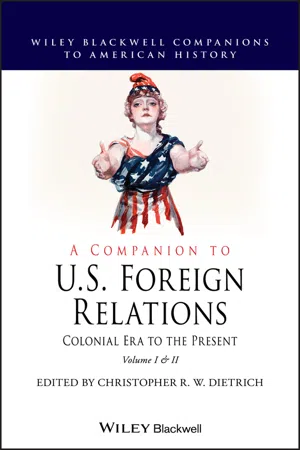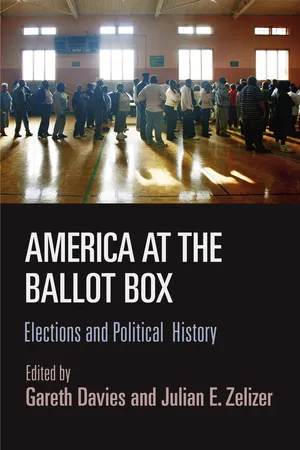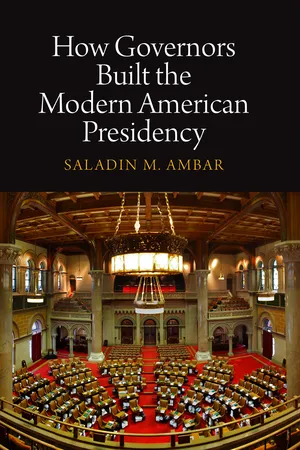History
Roosevelt Administration
The Roosevelt Administration refers to the presidency of Franklin D. Roosevelt, who served from 1933 to 1945. This period was marked by significant government intervention in the economy to combat the Great Depression, as well as the implementation of social welfare programs through the New Deal. Roosevelt's leadership also played a crucial role in guiding the United States through World War II.
Written by Perlego with AI-assistance
Related key terms
3 Key excerpts on "Roosevelt Administration"
- eBook - ePub
A Companion to U.S. Foreign Relations
Colonial Era to the Present
- Christopher R. W. Dietrich(Author)
- 2020(Publication Date)
- Wiley-Blackwell(Publisher)
Chapter Eighteen Insulation : The Presidency of Franklin D. Roosevelt During the Years 1933–1941Kiran Klaus PatelThe presidency of Franklin D. Roosevelt (1933–1945) is often seen as a pivotal and transformative period in the history of American foreign relations. The United States played a crucial role in World War II and emerged from the conflict as one of the world's two superpowers, wielding global influence as never before. Roosevelt himself is often associated with a particularly internationalist brand of foreign policy, even if his approach was not canonized in a neologism, as in the case of his Democratic predecessor, Woodrow Wilson – there is no “Rooseveltism” to match “Wilsonianism.” Interestingly, the term most closely associated with FDR's presidency – the New Deal – is normally reserved for his pre‐war domestic policies. And while some of the defenders of the 32nd president praise his foreign policy and describe him as a capable and farsighted statesman, others have been much more critical, accusing him either of a lack of vision and a politics of procrastination or of leading the country into a needless war. To this day, Roosevelt's foreign policies remain highly controversial and evade easy categorization.This chapter examines the foreign relations of the Roosevelt presidency until 1941, when the United States joined World War II. It advances in three steps. In the first, it provides a succinct summary of the main historiographical trends and interpretations. The second summarizes my own arguments in this context, before the third points to new avenues of research. In sum, the chapter seeks to demonstrate that the pre‐1941 Roosevelt presidency deserves more attention that it has experienced to date. Research has to go further in overcoming old categories and dichotomies, such as isolationism versus internationalism, and in challenging established but too‐narrow differentiations between foreign affairs and domestic politics. Finally, the chapter argues for a more global approach to the history of U.S. foreign relations by bringing in transnational and comparative perspectives. - eBook - ePub
America at the Ballot Box
Elections and Political History
- Gareth Davies, Julian E. Zelizer(Authors)
- 2015(Publication Date)
- University of Pennsylvania Press(Publisher)
For some, the failure of the New Deal to achieve its more social democratic aspirations—for economic planning, labor regulation, social provision—was portentous, ensuring that politics during the 1940s and 1950s (or even beyond) would have a constricted, complacent character, and that the fundamental problems of American democracy and American capitalism would go unattended. To the extent that the New Deal yielded an enduring political era, it is notable primarily for its limits. 1 For other historians, the New Deal break with the nation’s antistatist past was more impressive: it was during the Depression decade that Americans came, however uneasily, to look to government to protect them from adversity, and this constituted a historic change in political culture. According to this view, all presidents during the post–World War II era, Republican as well as Democrat, conservative as well as liberal, lived “in the shadow of FDR,” and the new legitimacy of the state, this new habit of looking to Washington for help, constituted the lasting and vitally important consequence of the New Deal. 2 That the emergency of the Great Depression should have been followed in such short order by World War II and the Cold War complicates one’s task in attempting to characterize the distinct legacy of the New Deal. How does one separate out the respective contributions of reform politics and national security politics to American state building during the middle decades of the twentieth century? In statistical terms, the answer is straightforward: government spending, tax revenues, and the federal workforce all grew significantly during the 1930s, but they then increased massively during World War II, and those increases were maintained during the early Cold War period - Saladin M. Ambar(Author)
- 2012(Publication Date)
- University of Pennsylvania Press(Publisher)
Paradoxically, in winning for a time some of the more cherished concessions demanded by progressives, Roosevelt's governorship initiated other steps away from lasting democratic protections, widening the gap between the executive and the people. Roosevelt's time in Albany foreshadowed similar developments in his presidency. As Sidney Milkis and Michael Nelson point out, “By itself, Roosevelt's ability to get a considerable part of his program enacted in the absence of a national crisis and in spite of the tepid support, and sometimes the outright resistance, of his party indicated that a new era of presidential leadership had arrived. From now on, government action would be much more likely to bear the president's personal stamp than in the past.” 28 This state of affairs was largely due to the decline of parties and voter turnout, and the advent of more direct executive appeals for popular support. “The civic republican model,” noted the political scientist John Gerring, “in which the people courted statesmen, now stood on its head.” 29 Roosevelt expressed this burgeoning freedom from bossism well: “I myself am a cog in the New York machine,” he recognized, “but the machine must do right or this cog will begin to turn independently.” 30 Not all were pleased with the rise of such independence. By 1905, Louis Brandeis joined the chorus of disaffected progressives, albeit privately, deploring then President Roosevelt's “kingly attitude.” 31 By this time, the prerogatives of the new American executive were evident in a variety of venues. Indeed, when the first mayor of a newly consolidated New York City Robert Van Wyck gave a two-sentence inaugural address in 1898, it was an invocation of an executive zeitgeist. “Mr. Mayor, the people have chosen me to be mayor,” Van Wyck began
Learn about this page
Index pages curate the most relevant extracts from our library of academic textbooks. They’ve been created using an in-house natural language model (NLM), each adding context and meaning to key research topics.


